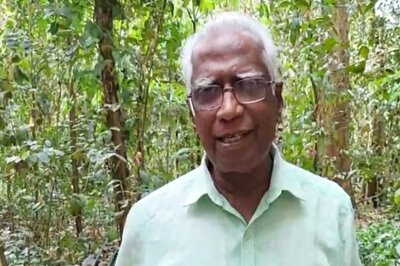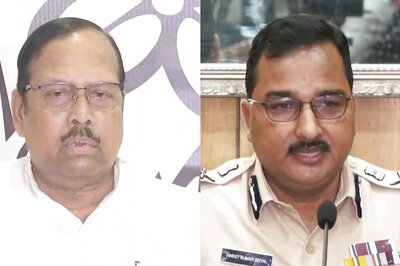
views
Mining is not new to the Khasi-Jaintia people of Meghalaya and iron smelting dates back 2,000 years.
The technology used for ore extraction was similar to that used in central India, says a study carried out by Pawel Prokop, a geo-environmental researcher with the Polish Academy of Sciences and his colleague, Ireneusz Suliga.
The scientists came to Meghalaya in 2013 to conduct their research. The two scientists from Poland were engaged in geo-environmental research in the Khasi hills and found charcoal and residual slag from iron extraction at several sites, including Nongkrem in East Khasi Hills where the slag is 2,040 years old.
Even today if one visits Rangjyrteh in Cherrapunjee (Sohra), one can still see iron slags lying around and huge stone containers that were cut out in the shape of bowls and were used for smelting iron. The iron implements were apparently sold to East Bengal which then sold those implements elsewhere.
The British found traces of this iron smelting when they entered these hills in 19th century and they spoke of a thriving iron smelting industry in the Khasi Hills then but could not date the advent of the iron smelting activity.
The two Polish scientists say that it’s now evident that the industry started over 2,000 years ago. Apparently charcoal was used for iron smelting. The scientists are, however, unsure if iron-smelting was discovered by the local Khasi people or it if the technique was brought to the hills by someone from other parts of India where again mining is an almost ancient activity.
As far as coal is concerned mining evidently started in the second half of the 19th century when the British entered the Khasi-Jaintia Hills, then under the composite state of Assam. According to the Geological Survey of India, there are proven reserves of 600 million tonnes of coal in with Meghalaya with an annual production of 5 million tonnes.
During the British period, coal was partly used for commercial purposes and partly for their consumption as a fuel for warming homes. The commercial production stopped because of the difficulty in transporting coal over difficult terrain. It was only after Meghalaya attained statehood in 1972 that coal mining was resumed on a commercial scale.
According to the Sixth Schedule of the Indian Constitution, land in Meghalaya belongs to the “people.” This includes land vested with communities, clans and individuals. Under the protection of the Sixth Schedule, where not just the land but everything under it also belongs to the people, a free-for-all mining exercise started without any technological know-how but using the traditional unscientific mining practices. Mine owners claim that scientific mining is not viable in Meghalaya since that would mean a heavy investment in machinery. When a PIL was field by a student’s body in Assam in 2014, citing that acid mine drainage has rendered the waters flowing downstream into Assam from Meghalaya has become toxic, the National Green Tribunal (NGT) banned further mining of coal in Meghalaya but allowed the extracted coal to be transported after it was duly assessed. This was a flawed exercise because the NGT did not have resources to monitor if coal mining continued after the ban, which it did.
And indeed the 17 miners trapped inside a mine in Jaintia Hills even now where the rescue operations continue were involved in coal mining by violating the NGT ban.
The NGT directed the state government to come with a comprehensive mining policy since the ban was imposed but that policy is yet to see the light of day. Sans a mining policy, coal mining allowed the flouting of all environmental norms. No labour laws operated there. Since coal in Meghalaya is located at shallow levels, the mines are narrow shafts approximately of approximately three feet in diameter. They can go up to about 300-350 feet down. Coal is lifted out of the shafts in small wooden boxes brought up by cranes and then dumped by the roadside and then loaded on to trucks.
Transportation of coal, too, is a lucrative business and most coal mine owners also own trucks. As in every mining hub, criminal activities are rampant. One characteristic of coal mining in Meghalaya is that labour is brought in from across the Bangladesh border and from Nepal. The locals don’t venture into this risky livelihood.
Documentary film maker Chandrashekhar Reddy’s film Fireflies in the Abyss captures the plight of these child-labourers who are forced into this risky livelihood to keep body and soul together and to support their families. The film focuses on young Suraj from Nepal who is barely 12-13-years-old and who enters the mines and works there for almost 14 hours a day because the more coal he digs, the more he earns.
This film has been shown at several national and international film festivals and is available on YouTube so there is nothing secret about the treacherous manner in which coal is mined in Meghalaya with scant regard for the human rights of those who enter the mines.
There have been no safeguards for the miners then and there are no safeguards now. And since governments, past and present, are complicit in allowing this criminal neglect of human rights to continue, and also because coal money funds all elections, no one actually wants to touch this issue with a barge pole.
And this is also not the first time that so many miners have been trapped in coal mines of Meghalaya without anyone making a big deal about it. In 2012, 15 miners were trapped inside a coal mine near Nangalbibra South Garo Hills. Their bodies were never recovered. This, too, happened due to sudden flooding of the mines. Usually flooding happens when miners hit into a wall of an abandoned mine filled with water. Miners can then do little to stop the flooding. It is a miracle that the 15 other miners managed to escape from that mine in Garo Hills while the rest met a watery grave.
In 1992, a similar incident happened in Garo Hills when 30 people died due to similar flooding of a mine. In this case, too, the miners hit an abandoned mine that was filled with water.
The local media reported these deaths and continued to follow up the stories. Some regional media, too, reported likewise. Columnists have been hammering on about the need for scientific mining that will look after the environmental concerns of Meghalaya where at last three important rivers of Jaintia Hills — the Myntdu, the Lukha and the Lunar have become toxic due to acid mine drainage (AMD) and today are devoid of any riverine life.
But such write-ups fall on deaf ears.
In 2014, Keith Schneider from Circle of Blue, US came to Meghalaya to document the high-risk coal mining activity in Meghalaya and the complete disregard for the large-scale environmental degradation that is now part of the Meghalaya landscape.
Schneider’s documentary, too, was shown but with little reaction from the rest of the world.
In June 2018, when 13 school boys of a football team were trapped in a cave in Thailand, the whole world waited with bated breath to hear if they would be rescued and if they would survive. The boys were finally found by two British divers and later rescued by a very strategic operation but not without one of the rescuers losing his life due to asphyxiation. The rescue operation lasted nearly a week and the rescuers comprised US air force rescue specialists, and cave divers from the UK, Belgium, Australia, Scandinavia, and many other countries. Some had volunteered, and some were called in by Thai authorities.
Compared to that catastrophe, which caught world attention, the news about the miners trapped in the mines of Jaintia Hills, Meghalaya and Garo Hills in the past are not even a blip on the radar. Come to think of it, even national media in this country finds so much to report on politics but not on human tragedies; not especially if something happens in this distant periphery which rarely raises the conscience of the nation. (The author is a social activist and journalist based in Meghalaya. Views are personal)



















Comments
0 comment